Leveraging mobile payment systems in India can significantly boost conversions by simplifying the purchasing process and aligning with consumer preferences for convenience. With popular platforms like Paytm, Google Pay, PhonePe, and Amazon Pay, businesses can reduce transaction friction, leading to increased sales and improved customer satisfaction.
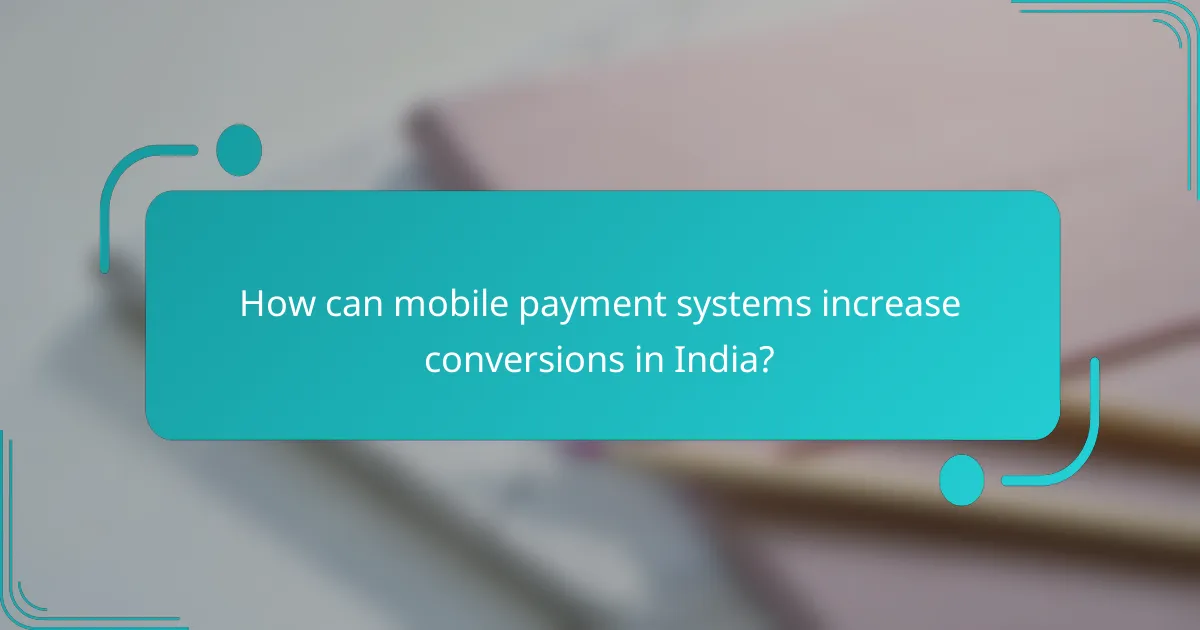
How can mobile payment systems increase conversions in India?
Mobile payment systems can significantly enhance conversions in India by streamlining the purchasing process and catering to consumer preferences for convenience. By integrating these systems, businesses can reduce friction in transactions, leading to higher sales and customer satisfaction.
Higher transaction speed
Mobile payment systems facilitate faster transactions, often completing payments in just a few seconds. This speed minimizes wait times, encouraging customers to finalize their purchases rather than abandon their carts. For instance, using QR codes or digital wallets can cut transaction times to low tens of seconds.
Businesses should ensure their payment systems are optimized for quick processing to capitalise on this advantage. Slow payment gateways can lead to lost sales, so selecting a reliable provider is crucial.
Enhanced customer experience
Integrating mobile payment systems enhances the overall customer experience by offering a seamless and user-friendly interface. Customers appreciate the ability to pay via their smartphones without needing cash or cards, which aligns with the growing trend of digital transactions in India.
To improve customer satisfaction, businesses should provide multiple payment options, including UPI, mobile wallets, and credit/debit cards. This variety caters to different preferences and increases the likelihood of completing a sale.
Increased trust and security
Mobile payment systems often come with advanced security features, such as encryption and biometric authentication, which can increase customer trust. In India, where concerns about online fraud are prevalent, demonstrating a commitment to security can reassure customers and encourage them to make purchases.
Businesses should communicate their security measures clearly to customers, highlighting features like two-factor authentication and secure payment gateways. This transparency can foster trust and lead to higher conversion rates.
Access to a wider audience
By adopting mobile payment systems, businesses can tap into a broader audience, including tech-savvy consumers who prefer digital transactions. In India, where smartphone penetration is high, offering mobile payment options can attract younger demographics who are more likely to shop online.
To reach this audience effectively, businesses should promote their mobile payment capabilities through targeted marketing campaigns, emphasising convenience and speed. This approach can help capture the interest of potential customers who prioritise efficient shopping experiences.
Integration with loyalty programs
Mobile payment systems can be easily integrated with loyalty programs, providing customers with incentives to complete their purchases. By offering rewards or discounts for using mobile payments, businesses can encourage repeat transactions and increase customer loyalty.
Implementing a points system or exclusive offers for mobile payment users can enhance engagement. Businesses should communicate these benefits clearly at the point of sale to maximise participation and drive conversions.
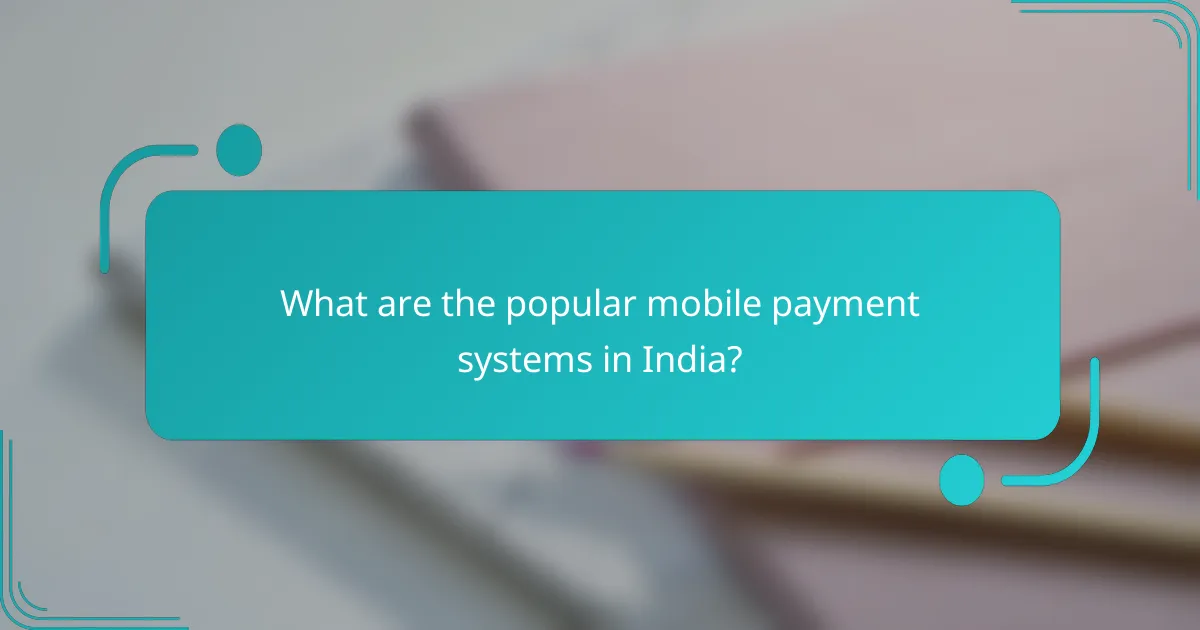
What are the popular mobile payment systems in India?
In India, several mobile payment systems have gained popularity, enabling users to make transactions conveniently using their smartphones. Key platforms include Paytm, Google Pay, PhonePe, and Amazon Pay, each offering unique features and benefits for users and businesses alike.
Paytm
Paytm is one of the leading mobile payment systems in India, allowing users to pay bills, recharge mobile phones, and make purchases at various merchants. It operates on a digital wallet model, where users can load money into their Paytm wallet and use it for transactions.
Businesses can benefit from Paytm by integrating its payment gateway, which supports multiple payment methods including credit/debit cards and net banking. This flexibility can enhance conversion rates, as customers appreciate having various options at checkout.
Google Pay
Google Pay is a widely used mobile payment platform that facilitates peer-to-peer transactions and merchant payments through the Unified Payments Interface (UPI). Users can link their bank accounts directly, making transactions seamless and quick.
For businesses, Google Pay offers a straightforward integration process and the ability to reach a large user base. Utilising Google Pay can lead to increased conversions, especially among tech-savvy customers who prefer quick and secure payment methods.
PhonePe
PhonePe is another prominent mobile payment system in India that leverages UPI for instant money transfers and payments. It allows users to pay bills, recharge, and shop online, all from a single app.
Merchants can benefit from PhonePe’s extensive reach and user-friendly interface. By integrating PhonePe into their payment options, businesses can cater to a growing demographic that favours UPI transactions, thus boosting conversion rates.
Amazon Pay
Amazon Pay allows users to make payments for purchases on Amazon and at various partner merchants. It integrates with the Amazon ecosystem, making it convenient for users who frequently shop online.
For businesses, accepting Amazon Pay can enhance customer trust and loyalty, as users are more likely to complete purchases using a familiar payment method. This can lead to higher conversion rates, particularly among existing Amazon customers.
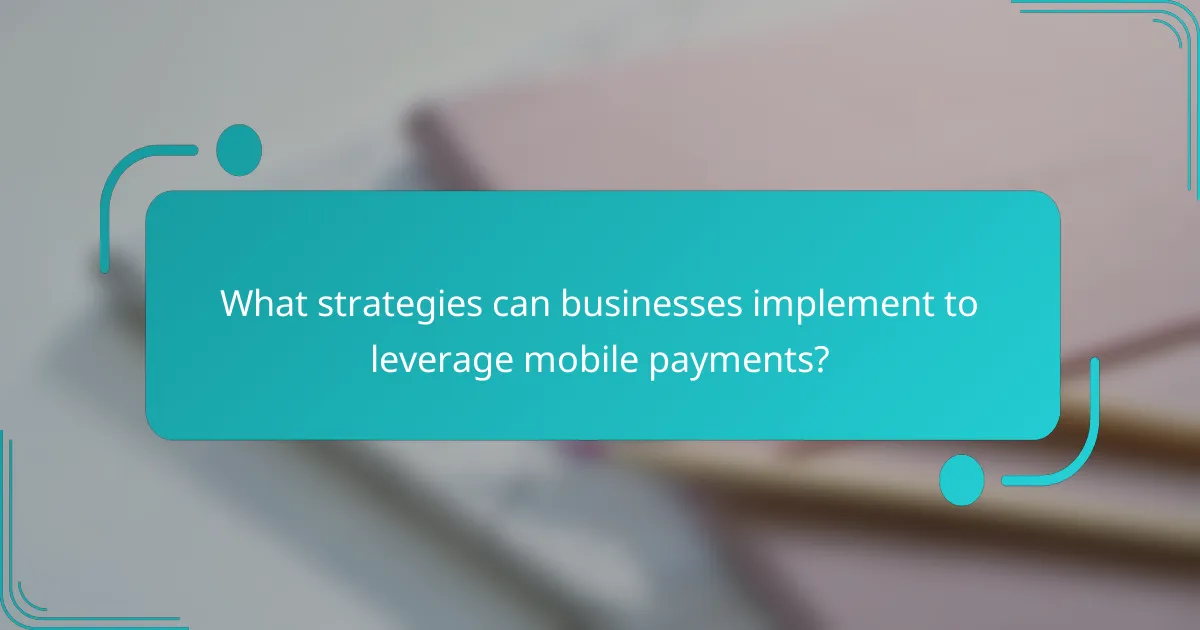
What strategies can businesses implement to leverage mobile payments?
Businesses can enhance conversions in India by adopting several effective strategies for leveraging mobile payment systems. These strategies include optimising mobile websites, implementing QR code payments, utilising targeted promotions, and enhancing customer support.
Optimise mobile websites
To leverage mobile payments effectively, businesses must ensure their websites are optimised for mobile devices. This means creating a responsive design that loads quickly and provides an intuitive user experience. A well-optimised site can reduce bounce rates and encourage customers to complete their purchases.
Key elements to consider include simplifying navigation, minimising the number of steps to checkout, and ensuring that payment buttons are easily accessible. Testing your website on various devices can help identify any issues that may hinder mobile payment usage.
Implement QR code payments
QR code payments are a popular mobile payment method in India, allowing customers to make transactions quickly and securely. Businesses can generate unique QR codes for their products or services, enabling customers to scan and pay using their mobile wallets.
To implement this, ensure that your QR codes are prominently displayed and easy to scan. Consider providing instructions on how to use QR codes for customers who may be unfamiliar with the process. This can significantly enhance the checkout experience and increase conversion rates.
Utilise targeted promotions
Offering targeted promotions can incentivise customers to use mobile payments. Businesses can create special discounts or cashback offers for transactions made through mobile payment systems, appealing to cost-conscious consumers.
Utilising data analytics to understand customer preferences and behaviours can help tailor these promotions effectively. For instance, sending personalised offers via SMS or app notifications can drive engagement and encourage mobile payment usage.
Enhance customer support
Providing robust customer support is crucial for businesses looking to leverage mobile payments. Customers may encounter issues during the payment process, and having accessible support can help resolve these problems quickly, fostering trust and loyalty.
Consider implementing multiple support channels, such as live chat, phone support, and FAQs specifically addressing mobile payment queries. Training staff to handle mobile payment issues efficiently can also improve customer satisfaction and encourage repeat business.
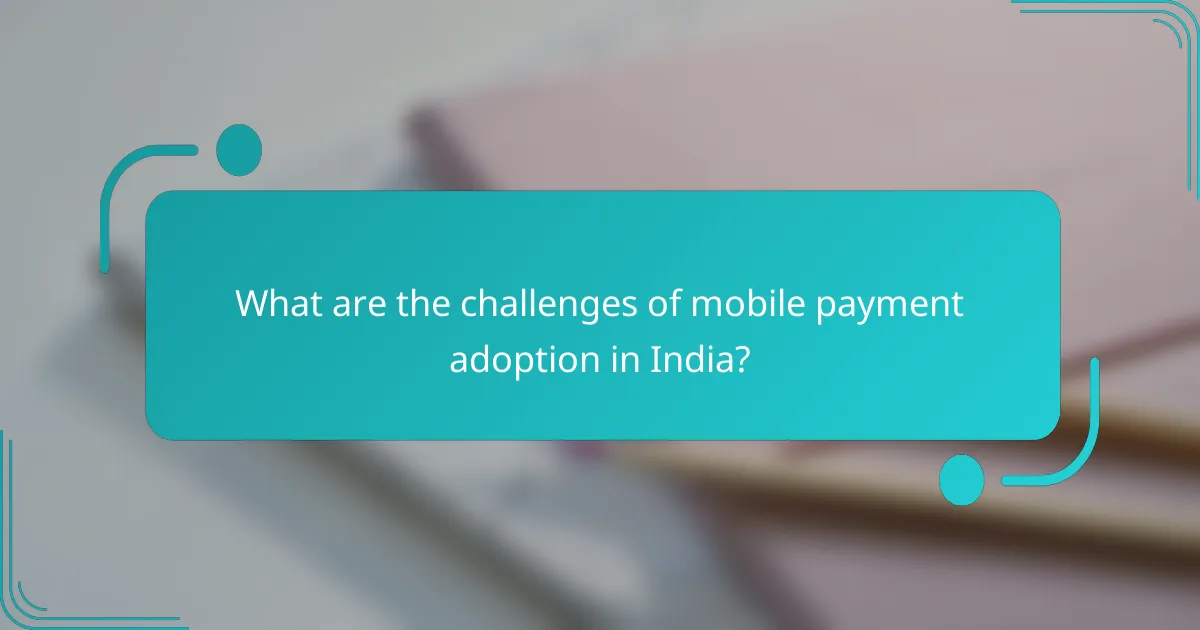
What are the challenges of mobile payment adoption in India?
Mobile payment adoption in India faces several challenges that hinder its growth, including digital literacy gaps, security concerns, and regulatory hurdles. Addressing these issues is crucial for enhancing the overall user experience and increasing transaction volumes.
Digital literacy gaps
Digital literacy gaps significantly impact mobile payment adoption in India, particularly among older populations and those in rural areas. Many potential users lack the necessary skills to navigate mobile applications or understand digital transactions, which can lead to frustration and reluctance to use these services.
To bridge this gap, targeted educational programs and community workshops can be implemented to teach users about mobile payments. Simple, user-friendly interfaces can also help make these systems more accessible to those with limited technical knowledge.
Security concerns
Security concerns are a major barrier to mobile payment adoption in India, as users fear fraud and data breaches. Reports of cybercrime can deter individuals from trusting mobile payment systems, especially if they are unfamiliar with security measures in place.
To alleviate these concerns, service providers should prioritise robust security features such as two-factor authentication and encryption. Regular communication about security practices and success stories can also help build trust among users.
Regulatory hurdles
Regulatory hurdles can complicate the landscape for mobile payment systems in India. Compliance with various regulations, such as those set by the Reserve Bank of India, can create challenges for service providers and may slow down innovation.
Staying informed about regulatory changes and actively engaging with policymakers can help businesses navigate these complexities. Collaborating with regulatory bodies to streamline processes and ensure compliance can also facilitate smoother operations in the mobile payment sector.
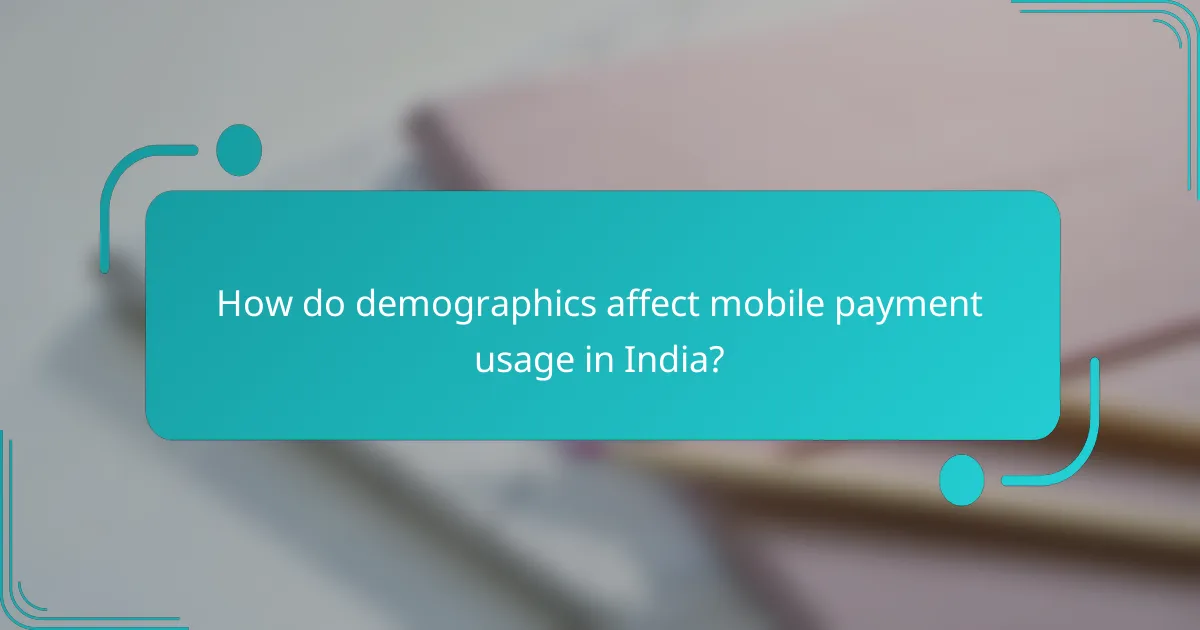
How do demographics affect mobile payment usage in India?
Demographics significantly influence mobile payment usage in India, with factors such as age, income, and education playing crucial roles. Younger populations and urban dwellers tend to adopt mobile payment systems more readily compared to older and rural demographics.
Urban vs rural usage
Urban areas in India show a higher adoption rate of mobile payment systems due to better internet connectivity and higher smartphone penetration. In cities, users often prefer digital transactions for convenience and speed, leading to a significant increase in e-commerce and service payments.
Conversely, rural regions face challenges such as limited internet access and lower smartphone usage, which hinder mobile payment adoption. However, initiatives to improve digital literacy and infrastructure are gradually changing this landscape, encouraging more rural users to engage with mobile payment systems.
